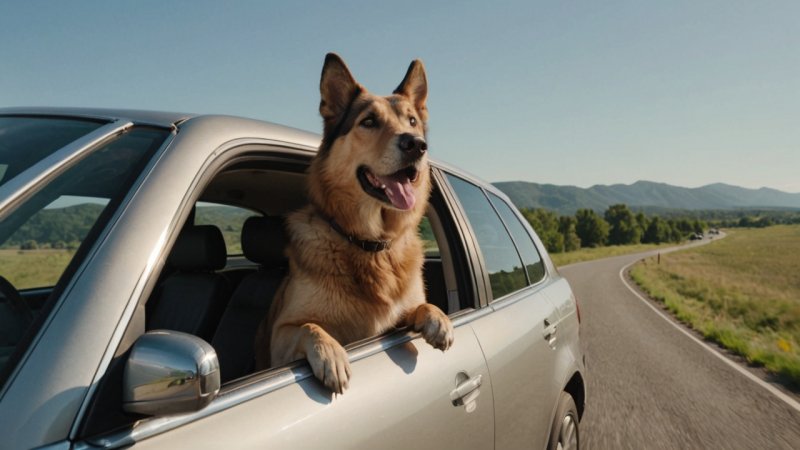Traveling with pets can be an incredibly rewarding experience, especially for those who consider their dogs as part of the family. However, when it comes to large dogs, there are unique challenges and considerations that pet owners must keep in mind. In this comprehensive guide, we will explore essential tips for traveling with large dogs, from planning your journey to ensuring their comfort and safety, as well as some unique experiences that you can share together along the way.
Understanding Your Dog's Needs
Before embarking on any trip, it’s crucial to understand your dog’s specific needs. Large dogs often require more space and have different temperaments and energy levels compared to smaller breeds. Here are some key factors to consider:
- Exercise: Large dogs typically have higher energy levels and require ample exercise. Make sure to plan for regular breaks during your journey to allow your dog to stretch their legs and relieve themselves.
- Comfort: Ensure your dog has enough space in your vehicle. A comfortable crate or a well-padded back seat can make a significant difference in their travel experience.
- Health: Consult your veterinarian before traveling, especially if your dog has pre-existing health conditions. Ensure they are up-to-date on vaccinations and flea/tick preventatives.
- Behavior: Know your dog's temperament. Some large breeds may feel anxious in new environments, while others may be more adaptable. Training and socialization can help ease travel-related anxiety.
Planning Your Journey
Proper planning is essential for a smooth trip with your large dog. Here’s how to ensure that you cover all bases:
Choosing the Right Mode of Transportation
The way you travel can significantly impact your dog’s comfort. Here are some options:
- Car Travel: This is often the most convenient option for large dogs. Ensure your vehicle is suitable for your pet. Use a pet seatbelt or a crate for safety.
- Air Travel: If flying, check with the airline regarding their pet policy, as many have restrictions on the size and weight of dogs allowed in the cabin. Larger dogs may need to travel in the cargo hold, which can be stressful.
- Train/Bus Travel: Public transport can be tricky for large dogs. Research the policies of the transport company, as some may not allow larger breeds on board.
Finding Pet-Friendly Accommodations
Not all hotels or accommodations welcome pets, so it’s crucial to find places that do. Here are some tips:
- Research: Use travel websites to filter searches for pet-friendly options. Look for reviews from other pet owners to gauge the suitability.
- Contact Hotels Directly: Sometimes, pet policies may vary by location, so it’s wise to call ahead to confirm if your large dog is welcome.
- Consider Vacation Rentals: Platforms like Airbnb or Vrbo often have more flexible pet policies, especially if you rent an entire home.
Preparing for the Trip
Preparation is key. Here’s how to ensure that you and your large dog are ready for the adventure:
Packing Essentials
Make a checklist of items you’ll need for your dog:
- Food and Water: Bring enough food for the duration of your trip and a portable water bowl.
- Leash and Collar: Have a sturdy leash and collar, along with identification tags.
- Comfort Items: Bring your dog’s favorite blanket or toy to provide comfort in unfamiliar surroundings.
- Health Records: Keep a copy of your dog’s health records and vaccination history in case of emergencies.
Behavioral Training
Before you travel, ensure that your dog is well-trained and socialized. This is especially important for large breeds, as they can be intimidating to others:
- Basic Commands: Ensure your dog knows basic commands like sit, stay, and come.
- Socialization: Expose your dog to various environments and people before your trip to reduce anxiety.
On the Road: Safety and Comfort
Once you’re on your way, keeping your dog safe and comfortable is paramount:
During the Journey
While traveling, adhere to the following safety measures:
- Regular Breaks: Stop every couple of hours for bathroom breaks and to let your dog stretch.
- Temperature Control: Make sure your vehicle is well-ventilated and not too hot or cold.
- Secure Your Dog: Use a pet seatbelt or crate to prevent them from moving around while you’re driving.
Managing Anxiety
Travel can be stressful for dogs, especially if they are not used to being in the car for long periods. Consider the following:
- Calming Aids: Talk to your vet about calming aids or anxiety wraps that can help ease your dog’s stress.
- Familiarity: Bring along familiar items like their bed or favorite toys to provide comfort.
Exploring New Destinations
Once you reach your destination, it’s time to explore! Here are some unique experiences you can share with your large dog:
Outdoor Adventures
Many destinations offer dog-friendly outdoor activities:
- Hiking: Research local trails that allow dogs. Ensure they are suitable for your dog’s fitness level.
- Beaches: Some beaches are pet-friendly, allowing dogs to play in the sand and water.
- Parks: Look for dog parks where your pup can socialize and play with other dogs.
Cultural Experiences
Some cities are more welcoming to pets than others. Consider these options:
- Dog-Friendly Cafes: Many cities have cafes or restaurants that allow dogs on patios or even inside.
- Pet-Friendly Tours: Some tour companies offer pet-friendly options, allowing you to explore with your dog.
Conclusion
Traveling with large dogs can be a fulfilling experience that strengthens the bond between you and your furry friend. By understanding your dog's needs, planning your journey meticulously, and ensuring their comfort and safety during the trip, you can create memorable experiences together. From outdoor adventures to exploring pet-friendly destinations, the world is full of possibilities for you and your large dog. Remember that every trip is an opportunity to create lasting memories, so embrace the journey and enjoy every moment with your beloved pet.






